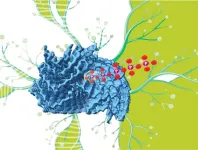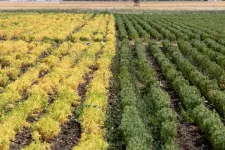(Press-News.org) Indigenous burning practices in Australia once halved shrub cover, reducing available fuels and limiting wildfire intensity for thousands of years, but the removal of these practices following European colonization has led to an increase in the tinder that has fueled today’s catastrophic megafires, researchers report. The findings suggest that reintroducing cultural burning practices could provide a strategy to curb future fires. “Through detailed histories of Indigenous burning regimes across the world and Indigenous-led collaborations in contemporary wildfire management projects, we can inform sustainable and healthy solutions that ‘tame the flames’ threatening global socioenvironmental systems,” write the authors. Climate change is increasing the frequency and intensity of wildfires in many regions, particularly the forests of western North America and southeastern Australia. In addition to anthropogenic climate change, human forest management and fire suppression have led to a buildup of shrubby vegetation that fuels more intense fires. This dense shrub layer allows ground fires to spread to the forest canopy above, resulting in destructive and difficult-to-control crown fires. For millennia, humans have used fire as a tool, with Indigenous groups worldwide practicing “cultural burning” to promote biodiversity, improve hunting, and reduce fuel loads through frequent, low-intensity burns. This approach creates spatial diversity in vegetation and helps to prevent severe wildfires. In fire-prone regions like southeastern Australia, colonial suppression of Indigenous burning practices has caused fuel loads to increase, resulting in more frequent high-intensity fires. However, while traditional Indigenous burning practices in Australia have recognized benefits, data on vegetation structure under Indigenous management is limited. To address this gap, Michela Mariani and colleagues analyzed 2833 archaeological and palaeoecological records of vegetation cover, climate, fire activity, and human population size, spanning from the pre-human landscapes of the Last Interglacial to the post-colonial period. Mariani et al. found that Indigenous population expansion and cultural burning practices during the mid-late Holocene (6,000 to 1,000 years ago) coincided with a roughly 50% reduction in shrub cover (from ~30% from the early to mid-Holocene to 15% during the late to mid-Holocene). However, since British colonization in the 18th century, shrub cover has surged to an unprecedented 35% - surpassing levels seen even before human presence on the continent – contributing to modern megafires.
END
Indigenous population expansion and cultural burning reduced shrub cover that fuels megafires in Australia
Summary author: Walter Beckwith
2024-10-31
ELSE PRESS RELEASES FROM THIS DATE:
Echolocating bats use an acoustic cognitive map for navigation
2024-10-31
Echolocating bats have been found to possess an acoustic cognitive map of their home range, enabling them to navigate over kilometer-scale distances using echolocation alone. This finding, recently published in Science, was demonstrated by researchers from the Max Planck Institute of Animal Behavior, the Cluster of Excellence Centre for the Advanced Study of Collective Behaviour at the University of Konstanz Germany, Tel Aviv University, and the Hebrew University of Jerusalem, Israel.
Would you be able to instantly recognize ...
Researchers solve medical mystery of neurological symptoms in kids
2024-10-31
Most people who visit a doctor when they feel unwell seek a diagnosis and a treatment plan. But for some 30 million Americans with rare diseases, their symptoms don’t match well-known disease patterns, sending families on diagnostic odysseys that can last years or even lifetimes.
But a cross-disciplinary team of researchers and physicians from Washington University School of Medicine in St. Louis and colleagues from around the world has solved the mystery of a child with a rare genetic illness that did not fit any known disease. The team found a link between the child’s neurological symptoms and a genetic change that affects how proteins ...
Finding a missing piece for neurodegenerative disease research
2024-10-31
Research led by the University of Michigan has provided compelling evidence that could solve a fundamental mystery in the makeup of fibrils that play a role in Alzheimer's, Parkinson's and other neurodegenerative diseases.
"We've seen that patients have these fibril structures in their brains for a long time now," said Ursula Jakob, senior author of the new study. "But the questions are what do these fibrils do? What is their role in disease? And, most importantly, can we do something to get rid of them if they are responsible for these devastating diseases?"
Although the new finding does not explicitly answer those questions, it may provide a missing ...
Journal of the Royal Society of Medicine ranked in global top ten medical journals
2024-10-31
Notes to editors
For further information please contact:
Karen Nower
Media Office, Royal Society of Medicine
M: +44 (0)7587 084402
E: media@rsm.ac.uk
The Journal of the Royal Society of Medicine (JRSM) has been ranked as one of the world’s top ten general medicine journals for the first time.
Being placed tenth out of 329 ‘general and internal medicine’ titles in Clarivate’s 2023 Journal Citation Reports (JCR), this is JRSM’s highest ever ranking to date, having risen yearly ...
A new piece in the grass pea puzzle - updated genome sequence published
2024-10-31
An international research collaboration has completed the most detailed genome assembly to date of grass pea (Lathyrus sativus).
This new chromosome-scale reference genome published in Scientific Data offers new potential to accelerate modern breeding of this underutilised legume for climate-smart agriculture.
Nearly twice the size of the human genome, the sequence was assembled from scratch and improves on an earlier draft assembly of the vigorous grass pea line LS007.
“We ...
“Wearable” devices for cells
2024-10-31
CAMBRDIGE, MA – Wearable devices like smartwatches and fitness trackers interact with parts of our bodies to measure and learn from internal processes, such as our heart rate or sleep stages.
Now, MIT researchers have developed wearable devices that may be able to perform similar functions for individual cells inside the body.
These battery-free, subcellular-sized devices, made of a soft polymer, are designed to gently wrap around different parts of neurons, such as axons and dendrites, without damaging the cells, upon wireless actuation with light. By snugly wrapping neuronal processes, they could be used to measure ...
Cancer management: Stent sensor can warn of blockages in the bile duct
2024-10-31
Images
Stents to treat various blockages in the human body can themselves become blocked, but a new sensor developed at the University of Michigan for stents that are used in the bile duct may one day help doctors detect and treat stent blockages early, helping keep patients healthier.
Bile duct blockages can cause jaundice, liver damage and potentially life-threatening infections. Conditions that cause the bile ducts to narrow and close, including pancreatic and liver ...
Nov. 14 AARP Author Q&A at GSA 2024 in Seattle: Debra Whitman, Global Aging Expert and Author of ‘The Second Fifty: Answers to the 7 Big Questions of Midlife and Beyond’
2024-10-31
Author Q&A: Debra Whitman, Global Aging Expert and Author of “The Second Fifty”
Date: Thursday, November 14
Time: 4:30 to 5:30 p.m. PT
Location: Seattle Convention Center Arch Building Room 305
Registration: GSA 2024 Annual Scientific Meeting media registration is required to attend this event.
During this meet-the-author media roundtable, Debra Whitman, executive vice president and chief public policy officer at AARP, will discuss her new book, “The Second Fifty: Answers to the 7 Big ...
Autistic psychiatrists who don't know they're autistic may fail to spot autism in patients
2024-10-31
Groundbreaking research exploring the experiences of autistic psychiatrists has revealed that psychiatrists who are unaware that they themselves are autistic may fail to recognise the condition in their patients. The study, conducted by researchers from University College Dublin, London South Bank University, Brighton and Sussex Medical School, is the first of its kind to delve into the lives of neurodivergent psychiatrists. It was published today in BJPsych Open.
"Knowing that you are autistic can be positively life-changing," said the study author Dr Mary Doherty, Clinical Associate ...
New findings on animal viruses with potential to infect humans
2024-10-31
COLUMBUS, Ohio – Scientists investigating animal viruses with potential to infect humans have identified a critical protein that could enable spillover of a family of organisms called arteriviruses.
In a new study, researchers identified a protein in mammals that welcomes arteriviruses into host cells to start an infection. The team also found that an existing monoclonal antibody that binds to this protein protects cells from viral infection.
Arteriviruses circulate broadly in many types of mammals around the world that serve as natural hosts – such as ...
LAST 30 PRESS RELEASES:
Common brain parasite can infect your immune cells. Here's why that's probably OK
International experts connect infections and aging through cellular senescence
An AI–DFT integrated framework accelerates materials discovery and design
Twist to reshape, shift to transform: Bilayer structure enables multifunctional imaging
CUNY Graduate Center and its academic partners awarded more than $1M by Google.org to advance statewide AI education through the Empire AI consortium
Mount Sinai Health system receives $8.5 million NIH grant renewal to advance research on long-term outcomes in children with congenital heart disease
Researchers develop treatment for advanced prostate cancer that could eliminate severe side effects
Keck Medicine of USC names Christian Pass chief financial officer
Inflatable fabric robotic arm picks apples
MD Anderson and SOPHiA GENETICS announce strategic collaboration to accelerate AI-driven precision oncology
Oil residues can travel over 5,000 miles on ocean debris, study finds
Korea University researchers discover that cholesterol-lowering drug can overcome chemotherapy resistance in triple-negative breast cancer
Ushikuvirus: A newly discovered giant virus may offer clues to the origin of life
Boosting the cell’s own cleanup
Movement matters: Light activity led to better survival in diabetes, heart, kidney disease
Method developed to identify best treatment combinations for glioblastoma based on unique cellular targets
Self-guided behavioral app helps children with epilepsy sleep earlier
Higher consumption of food preservatives is associated with an increased risk of type 2 diabetes
NTU Singapore-led team captures first-ever ‘twitch’ of the eye’s night-vision cells as they detect light, paving the way for earlier detection of blindness-causing diseases
Global aviation emissions could be halved through maximising efficiency gains, new study shows
Fewer layovers, better-connected airports, more firm growth
Exposure to natural light improves metabolic health
As we age, immune cells protect the spinal cord
New expert guidance urges caution before surgery for patients with treatment-resistant constipation
Solar hydrogen can now be produced efficiently without the scarce metal platinum
Sleeping in on weekends may help boost teens’ mental health
Study: Teens use cellphones for an hour a day at school
After more than two years of war, Palestinian children are hungry, denied education and “like the living dead”
The untold story of life with Prader-Willi syndrome - according to the siblings who live it
How the parasite that ‘gave up sex’ found more hosts – and why its victory won’t last
[Press-News.org] Indigenous population expansion and cultural burning reduced shrub cover that fuels megafires in AustraliaSummary author: Walter Beckwith





